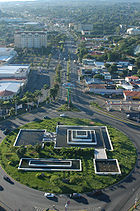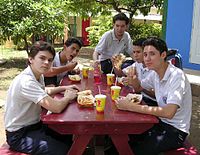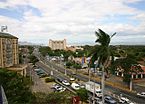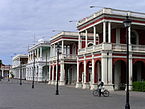- Demographics of Nicaragua
-
This article is about the demographic features of the population of Nicaragua, including population density, ethnicity, education level, health of the populace, economic status, religious affiliations and other aspects of the population.
Demographics of Nicaragua 
Managua, capital and largest city of Nicaragua Population 5,675,356 (2007 est.)[1] Male population 2,839,168 Female population 2,836,188 Population growth 1.855% Birth rate 24.12/1,000 Death rate 4.42/1,000 Infant mortality rate 27.14/1,000 Life expectancy 70.92 years Nationality Nicaraguan Demographic bureaus INEC According to the CIA World Factbook, Nicaragua has a population of 5,675,356. Mestizos (mixed Amerindian and white) make up about 69% of the population, and whites 17%. The remainder of the Nicaraguan population is 9% black, and 5% Amerindian. Nicaraguan demographics reflected a different composition prior to the Sandinista revolution of 1979 since most of the migration during the years that followed were primarily of upper or middle class Nicaraguans, a group primarily made up of whites. A growing number of these expats have returned, while many continue to live abroad.
The most populous city in the country is the capital city, Managua, with a population of 1.2 million (2005). As of 2005, over 4.4 million inhabitants live in the Pacific, Central and North regions, 2.7 in the Pacific region alone, while inhabitants in the Caribbean region only reach an estimated 700,000.[2]
The Census Bureau in Nicaragua is the National Institute of Statistics and Census (INEC). The institution is in charge of completing censuses and surveys. INEC ran its first census in 1906, the last census was taken in 2005, it was the eighth to date.
Contents
Demographics

Nicaraguan boys Group Number Mestizo (69%) 2,915,995 White (17%) 1,964,810 Black (9%) 510,782 Amerindian (5%) 283,767 Source: CIA World Factbook (2007) See also: NicaraguansIn the 19th century, there had been a substantial indigenous minority, but this group was also largely assimilated culturally into the mestizo majority. Primarily in the 19th century, Nicaragua saw several waves of immigration from other European nations. In particular the northern cities of Estelí, Jinotega and Matagalpa have significant fourth generation Germans. Most of Nicaragua's population lives in the western region of the country in the departments of Managua, Granada and Léon.
Ethnic groups
The majority of the Nicaraguan population are deemed Mestizo and white; 69% are Mestizos (mixed Amerindian and White) and 17% are deemed "white", with the majority of these being of Spanish, German, Italian, Portuguese and French ancestry. Mestizos and whites mainly reside in the western region of the country and combined make up 86% of the Nicaraguan population, approximately 4.8 million people.
About 9% of Nicaragua's population is black, or Afro-Nicaraguan, and mainly reside on the country's sparsely populated Caribbean or Atlantic coast. The black population is mostly of West Indian (Antillean) origin, the descendants of indentured laborers brought mostly from Jamaica when the region was a British protectorate. Nicaragua has the largest Afro Latin American population in Central America with the second largest percentage. There is also a smaller number of Garifuna, a people of mixed Carib, Angolan, Congolese and Arawak descent.
The remaining 5% are Amerindians, the unmixed descendants of the country's indigenous inhabitants. Nicaragua's pre-Columbian population consisted of many indigenous groups. In the western region the Nicarao people, whom the country is named after, were present along with other groups related by culture and language to the Mayans. The Caribbean coast of Nicaragua was inhabited by indigenous peoples who were mostly chibcha related groups that had migrated from South America, primarily present day Colombia and Venezuela. These groups include the Miskitos, Ramas and Sumos. In the 19th century, there was a substantial indigenous minority, but this group was also largely assimilated culturally into the mestizo majority. In the mid-1980s, the government divided the department of Zelaya - consisting of the eastern half of the country — into two autonomous regions and granted the black and indigenous people of this region limited self-rule within the Republic.
Indigenous population
Those belonging to recognized indigenous communities (2005) Rama 4,185 0.9% Garifuna 3,271 0.7% Sumo 9,756 2.2% Miskito 120.817 27.2% Ulwa 698 0.2% Creole 19,890 4.5% Sutiava 19,949 4.5% Nicarao 11,113 2.5 Chorotega 46,002 10.4 Matagalpa 15,240 3.4% According to the 2005 census, 443,847 inhabitants declared themselves Amerindian (Indigenous). Over 50% of the population lived in rural areas. With 120,817 inhabitants declaring themselves Miskito, they make up 27.2% of the total Indigenous population, followed by the Caribbean Coast mestizos. In addition to the inhabitants who declared themselves Indigenous, approximately 13,640 answered "Other" totaling 3.1%. Another 47,473 responded "Not Sure" and an additional 19,460 responded "Ignore", totaling 15.1%.[2]
Immigration
Relative to its overall population, Nicaragua has never experienced any large scale wave of immigrants. The total number of immigrants to Nicaragua, both originating from other Latin American countries and all other countries, never surpassed 1% of its total population prior to 1995. The 2005 census showed the foreign-born population at 1.2%, having risen a mere .06% in 10 years.[2] This is not to say that immigrants were not important to the evolution of Nicaraguan society and the Nicaraguan nation.
In the 19th century Nicaragua experienced a wave of immigration, primarily from Europe. In particular, families from Germany, Italy, Spain, France and Belgium generally moved to Nicaragua to set up businesses with money they brought from Europe. They established many agricultural businesses such as coffee and sugar cane plantations, and also newspapers, hotels and banks.
There is also a small Middle Eastern-Nicaraguan community of Syrian, Armenian, Palestinian Nicaraguan, Jewish Nicaraguan, and Lebanese people in Nicaragua with a total population of about 30,000. There is also an East Asian community of Japanese, Taiwanese and Chinese. The Chinese Nicaraguan population is estimated at around 12,000[citation needed]. The Chinese arrived in the late 19th century but were unsubstantiated until the second census (in 1920) revealed 400 people of the Chinese nationality.
Emigration
During the Nicaraguan Revolution and the Civil War, thousands of Nicaraguans left the country. After the 1990 Nicaraguan Elections some people returned, but many more emigrated during the rest of the decade. In 1998, the Hurricane Mitch killed almost 4,000 people in the country and destroyed much of the Nicaraguan Economy, as a result thousands of Nicaraguans received the TPS for emigrate to the United States as "refugees".[3] In recent years, many Nicaraguans had left the country to escape to the poverty and unemployment.
Nicaraguan emigration is a recent process. During the 1990–2004 period, more than 800,000 Nicaraguans left the country, compared to 100,000 during the 1970–1989 period.[4] According to the World Bank, in 2005 there were 683,520 Nicaraguans living outside Nicaragua legally. If illegals are counted, some sources cite as many as 1,500,000 Nicaraguans living abroad by the end of 2005.[5] Nicaraguans are the third largest community of Central Americans living abroad, after Guatemalans and Salvadorans. Nicaragua is also the second country in Central America by percentage of population living abroad.
Remittances to Nicaragua represent about 15% of the country's GDP.[6] In 2008 Nicaragua received close to one billion dollars in remittances; an increase from the $750,000,000 received in 2007, according to the World Bank[7]
Population
The most populous city in Nicaragua is the capital city, Managua, with a population of 1.2 million (2005). As of 2005, over 4.4 million inhabitants live in the Pacific, Central and North regions, 2.7 in the Pacific region alone, while inhabitants in the Caribbean region only reach an estimated 700,000.[2]
According to the UN, Nicaragua has a population of 5,743,000 (2009 estimate) with a population growth rate of 1.31% and a birth rate of 24.9/1,000 population, third highest in the region. The life expectancy for Nicaraguans at birth is 72.90 years; 69.99 for males and 76.00 for females. Nicaragua is the second country in Central America by immigrants expulsion, 210,000 during the period 2005–2010, lower only than that of Guatemala.[citation needed]
Departments by population
Rank City Department Pop. Rank City Department Pop. 
1 Managua Managua 1,262,978 10 Estelí Estelí 201,548 2 Matagalpa Matagalpa 469,172 11 Granada Granada 168,186 3 Chinandega Chinandega 378,970 12 Jinotepe Carazo 166,073 4 León León 355,779 13 Rivas Rivas 156,283 Managua 5 Jinotega Jinotega 331,335 14 Juigalpa Chontales 153,932
Granada6 Bilwi RAAN 314,130 15 Boaco Boaco 150,636 7 Bluefields RAAS 306,510 16 Somoto Madriz 132,459 8 Masaya Masaya 289,988 17 San Carlos Río San Juan 95,596 9 Ocotal Nueva Segovia 208,523 18 Total -- 5,142,098 (2005) Source: National Institute of Statistics and Census (INEC).[8] Language
Languages of Nicaragua Language Speakers Arabic 400 Chinese 7,000 English 20,334 Garífuna 1,500 Miskito 154,400 Sign language 3,000 Spanish 4,347,000 Sumo 6,700 Rama 24 Creole English 30,000 Source: Ethnologue[9] Main article: Languages of NicaraguaThe official language of Nicaragua is Spanish, or Nicañol as Nicaraguan Spanish is sometimes referred to, and is spoken by the country's population. In Nicaragua the Voseo form is common, just as in other countries in Central and South America like Honduras, Argentina, and Uruguay. Spanish has many different dialects spoken throughout Latin America, Central American Spanish is the dialect spoken in Nicaragua.
- Phonology
Some other characteristics of Nicaraguan phonology include:
- /s/ at the end of a syllable or before a consonant is pronounced like [h].
- j (/x/), is aspirated; it is soft as the /h/ in English (e.g.: Yahoo).
- Intervocalic /b/, /d/, and /g/ show no sign of reduction, and are much more pronounced than in most dialects.
- In some regions the double /l/ is pronounced with a ( "Shhh") sound, Argentina has a similar accent.
- There is no confusion between /l/ and /r/, as in the Caribbean.
- /s/, /z/ and in some cases /c/ (as in cerrar) are pronounced as [s]
- /m/ at the end of a word tends to be pronounced as [n]
Nicaraguans on the Caribbean coast speak their indigenous languages and also English. The indigenous peoples of the east who use their original language tend to also speak Spanish and/or English, the main languages being Miskito language, Sumo language, and Rama language. Creole languages are also present in the Caribbean coast, Nicaragua Creole English has 30,000 speakers.
Nicaragua has many minority groups. Many ethnic groups in Nicaragua, such as the Chinese Nicaraguans and Palestinian Nicaraguans, have maintained their ancestral languages while also speaking Spanish and/or English. Minority languages include Chinese, Arabic, German, Italian among others. Nicaragua also has a total of 3 extinct languages.[10]
Nicaraguan Sign Language is also of particular interest to linguists.
Religion
Main article: Religion in NicaraguaReligious Affiliation in Nicaragua 
The Metropolitan Cathedral of the Immaculate Conception in Managua Religion Percentage Roman Catholic 58.5% Evangelical 21.6% Moravian 1.6% Jehovah's Witnesses 0.9% None 15.7% Other1 1.6% 1 Includes Buddhism, Islam, and Judaism among other religions. Source: 2005 Nicaraguan Census[11] Religion is a significant part of the culture of Nicaragua and forms part of the constitution. Religious freedom, which has been guaranteed since 1939, and religious tolerance is promoted by both the Nicaraguan government and the constitution. Bishops are expected to lend their authority to important state occasions, and their pronouncements on national issues are closely followed. They can also be called upon to mediate between contending parties at moments of political crisis.[12]
Although Nicaragua has no official religion it is nominally Roman Catholic. Practicing Roman Catholics are no longer the majority and are declining while evangelical Protestant groups and Mormons are growing rapidly have been growing since the 1990s. There are also strong Anglican and Moravian communities on the Caribbean coast.
Roman Catholicism came to Nicaragua in the 16th century with the Spanish conquest and remained, until 1939, the established faith. Protestantism and various Christian sects came to Nicaragua during the 19th century, but only during the 20th century have Protestant denominations gained large followings in the Caribbean Coast of the country. Popular religion revolves around the saints, who are perceived as intermediaries between human beings and God. Most localities, from the capital of Managua to small rural communities, honor patron saints, selected from the Roman Catholic calendar, with annual fiestas. In many communities, a rich lore has grown up around the celebrations of patron saints, such as Managua's Saint Dominic (Santo Domingo), honored in August with two colorful, often riotous, day-long processions through the city. The high point of Nicaragua's religious calendar for the masses is neither Christmas nor Easter, but La Purísima, a week of festivities in early December dedicated to the Immaculate Conception, during which elaborate altars to the Virgin Mary are constructed in homes and workplaces.[12]
Demographic statistics
The following demographic statistics are from the CIA World Factbook and the UN, unless otherwise indicated.
Ninety percent of Nicaraguans live in the Pacific lowlands and the adjacent interior highlands. The population is 54% urban with Managua (capital) being the largest city, home to over a million inhabitants. In addition, many Nicaraguans live abroad.
Age structure
0–14 years: 33.8% (male 1,025,426/female 988,148)
15–64 years: 62.9% (male 1,734,153/female 1,746,574)
65 years and over: 3.3% (male 79,589/female 101,466) (2009 est.)Birth rate
24.9/1,000 (2005–2010 est.)Death rate
4.7/1,000 (2005–2010 est.)Population growth rate
1.31% (2005–2010 est.)Net migration rate
-210,000 people (2005–2010 est.)[13]Sex ratio
at birth: 1.05 male(s)/female
under 15 years: 1.04 male(s)/female
15–64 years: 1.00 male(s)/female
65 years and over: 0.78 male(s)/female
total population: 1.00 male(s)/female (2009 est.)Total fertility rate
2.76 children born/woman (2005–2010 est.)Ethnic groups
Mestizo (mixed Amerindian and white) 69%, white 17%, black 9%, Amerindian 5%
Religions
Roman Catholic 58.5%, Evangelicals 21.6%, Moravian 1.6%, Jehovah's Witnesses 0.9%, other 1.6%, none 15.7% (2005 census).[14]
Languages
Spanish (official)
note: English and indigenous languages on Atlantic coastLiteracy
definition: age 15 and over can read and write
total population: 67.5%
male: 67.2%
female: 67.8% (2003 est.)See also
- Culture of Nicaragua
- Ethnic groups in Central America
- National Institute of Statistics and Census of Nicaragua
References
 This article incorporates public domain material from websites or documents of the CIA World Factbook.
This article incorporates public domain material from websites or documents of the CIA World Factbook.- ^ "Cia World Factbook 2007: Nicaragua". https://www.cia.gov/library/publications/the-world-factbook/index.html. Retrieved 2007-06-28.
- ^ a b c d "VIII Censo de Poblacion y IV de Vivienda" (in Spanish) (PDF). Instituto Nacional de Estadística y Censos. October 2005. http://www.inec.gob.ni/censos2005/ResumenCensal/RESUMENCENSAL.pdf. Retrieved 2007-07-07.
- ^ http://www.immigrantinfo.org/kin/nicaragua.htm
- ^ [1] In Spanish
- ^ [2] In Spanish
- ^ https://www.cia.gov/library/publications/the-world-factbook/geos/nu.html
- ^ http://siteresources.worldbank.org/INTPROSPECTS/Resources/334934-1199807908806/Nicaragua.pdf
- ^ "Nicaraguan 2005 Census" (PDF). INEC. http://www.inec.gob.ni/censos2005/ResumenCensal/RESUMENCENSAL.pdf. Retrieved 2007-09-19.
- ^ "Languages of Nicaragua". Ethnologue. http://www.ethnologue.com/show_country.asp?name=Nicaragua. Retrieved 2007-09-08.
- ^ Ethnologue Information on languages in Nicaragua
- ^ "2005 Nicaraguan Census" (in Spanish) (PDF). National Institute of Statistics and Census of Nicaragua (INEC): pp. 42–43. http://www.inec.gob.ni/censos2005/ResumenCensal/Resumen2.pdf. Retrieved 2007-10-30.
- ^ a b Dennis, Gilbert. "Nicaragua: Religion". Country Studies (Library of Congress). http://lcweb2.loc.gov/cgi-bin/query/r?frd/cstdy:@field(DOCID+ni0040). Retrieved 2007-10-30.
- ^ http://ddp-ext.worldbank.org/ext/ddpreports/ViewSharedReport?&CF=1&REPORT_ID=9147&REQUEST_TYPE=VIEWADVANCED&HF=N&WSP=N
- ^ http://www.inec.gob.ni/censos2005/ResumenCensal/Resumen2.pdf — p. 42-43
External links
Demographics of North America Sovereign states Antigua and Barbuda · Bahamas · Barbados · Belize · Canada · Costa Rica · Cuba · Dominica · Dominican Republic · El Salvador · Grenada · Guatemala · Haiti · Honduras · Jamaica · Mexico · Nicaragua · Panama · Saint Kitts and Nevis · Saint Lucia · Saint Vincent and the Grenadines · Trinidad and Tobago · United States
Dependencies and
other territoriesAnguilla · Aruba · Bermuda · Bonaire · British Virgin Islands · Cayman Islands · Curaçao · Greenland · Guadeloupe · Martinique · Montserrat · Puerto Rico · Saint Barthélemy · Saint Martin · Saint Pierre and Miquelon · Saba · Sint Eustatius · Sint Maarten · Turks and Caicos Islands · United States Virgin Islands
Categories:- Demographics of Nicaragua
- Nicaraguan society
Wikimedia Foundation. 2010.






